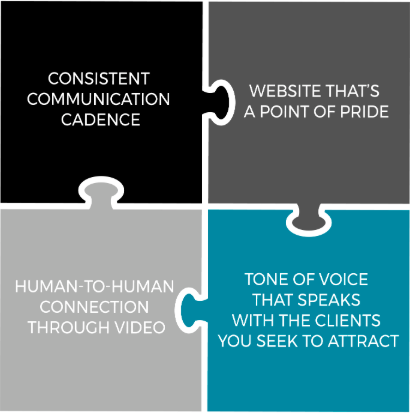Financial Advisor Business Development: ‘Preparation Meets Opportunity’
Posted by NICOLE HANDS
“Luck is what happens when preparation meets opportunity,” is a quote attributed to a Roman philosopher, Seneca. The sentiment captures a common thread we find in our research and analysis of the distinctions between financial advisors who achieve average results and those who are best-in-class.
Elite advisors, like those described in The Elite Advisor Playbook, ignite growth of their practice (opportunity) by being great marketers (preparation).
Before we get too far, let’s start with a simple question that isn’t quite as easy to answer as you might suspect: What’s the difference between client service and business development?
The obvious answer is that the latter seeks to attract new clients and the former seeks to keep existing ones happy. But to really answer the question in a thoughtful manner, you must first think about the most basic objectives of your firm — lowering client churn (client service) while adding more clients (business development). That is the simplest way to organically scale a wealth management firm, or any business, for that matter.
With this in mind, we can more deliberately think about HOW to achieve business development objectives. If you’re an advisor who wants to ramp up in this area — perhaps this was highlighted as an opportunity for you in the, “Are You An Elite Advisor?” quiz — you’re in the right place.
Blurred Lines (And That Should Be Welcome News)
First, some good news: Many of the elements that contribute to exceptional client service provide a foundation for elevating your business development activities. That’s a welcome reality if you’re on the “work smarter not harder” bandwagon, like me.
Specifically, your business development initiatives should be fueled by the following, which we detailed in an write-up about providing elite-level client service:

Because of the two-for-one nature of the above, the client service “how to” guide is an excellent resource if you’re just getting started with business development. Once you’ve started chipping away at those four areas, then it’s time to spend more time on optimizing your efforts, especially related to your website.
Your Website Is More Important Than Ever
Your website plays a huge role in shaping an investor’s perception of who you are, what you do, and how you can help them. You want there to be no doubt in a visitor’s mind that you are professional, legitimate, trustworthy, and an expert in wealth management.
A high-performing, contemporary website blurs the line between business development and client service because the digital resources required to support these functions are almost exactly the same.
For Elite Advisors, Their Website Is Their Hardest Working Employee
On a macro level, elite advisors continually ask questions about what’s working on their websites. On a micro level, they rely on strategically placed web forms and calls to action as ways to collect a prospect’s contact information and invite conversations.
Let’s dig further into both:
Macro (Website Data)
Many advisors — and maybe you’re in this camp — used to hold small cocktail or dinner gatherings for clients and/or prospects. I’m speaking of that time, pre-COVID, when in-person gatherings were still a thing, of course.
Events can be costly in both time and dollars. You have to find a space, get people in the room, plan the format, and pay the bill at the end. The data about what happened at and after the event is the critical information that enabled you to decide whether to hold more.

It’s the same for your website: the data is how you know what’s working. Elite advisors are hungry for information about what’s happening on their website so they can make decisions about how to spend their time — doing more of the things that work, and cutting their losses when the data doesn’t pan out.
Here’s a concrete example: Let’s say you notice a webpage with a higher volume of traffic than others. It tells you something is working. You might decide to share the content on social media or send out an email alert as a way of getting this high-performing piece of content in front of even more eyes. Or, you might decide to expand upon the topic in a white paper or video.
Micro (User Data)
The first goal of your business development activities is to eventually collect new contact information — whether this happens because someone gives it to you by completing a form on your website, or the exchange takes place as a result of someone proactively seeking to connect with you by phone or email.
Elite advisors make it easy for web visitors to find the advisor’s contact information. They also offer multiple forms of interaction so the user client can choose their own adventure based on the potential client’s preferred mode of interaction. We usually see elite advisors offering their email address, phone number, LinkedIn profile, and a meeting scheduling tool that automatically integrates with their calendar.
Best-in-class advisors also rely on strategically placed forms on their website to collect a user’s contact information in exchange for subscribing to the advisor’s blog, accessing a marquee piece of content (such as a research piece), or requesting a consultation.
If you are skeptical about this, consider that over the last 12 months, 591 individuals have filled out a form on Blueprint Investment Partner’s website, which represents a 110% improvement over the previous 12 months. In exchange for producing content our audience is thirsting for, we benefit from knowing who our interested users are, how we acquired them, and what their demonstrated interests are based on how they interact with our website. Equally important for the purposes of this briefing, all this data makes it easy for us to understand if these folks are potential leads or passively interested followers.
I’m convinced that this approach is the difference between Blueprint being a meandering firm and one that is purposeful in fulfilling its growth objectives.
We Can Help Advisors Replicate Our Approach
Blueprint is committed to helping advisors grow and sustain their businesses through investment and practice management services, and we welcome the opportunity to discuss lessons we’ve learned from our own business development approach. Please let us know if you’re interested in a conversation.
In addition to these one-off conversations, a concrete offering we have for advisors that supports their business development activities is our Elite Advisor Program, which provides some of the inputs advisors need to attract interest. For example, we produce blog content that advisors can share with clients, posted on their website, and emailed to prospects. If this is of interest to you, let’s chat.

